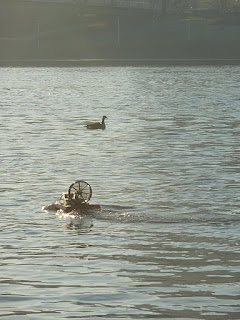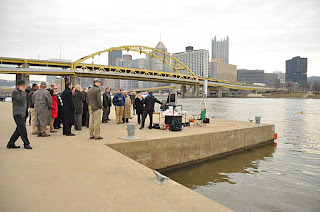In November we went out to Gowanus Canal, one of the dirtiest pieces of water you can imagine, right in the heart of Brooklyn (that part you might believe). It was a two day trip, with two objectives. First, we wanted to meet with and integrate the sensor of a New York company called WaterCanary. They are building a pretty cool sensor that will eventually allow real-time, low-cost measurement of a low of stuff about water. Then we wanted to test in the canal to show that water that you can smell from about a kilometer away is actually pretty dirty.
We turned up early (6am!) to do the sensor integration at the WaterCanary offices and hit every possible snag one could hit. Nothing worked. Nothing. An integration that should have taken an hour took six hours. Finally, it worked and we jumped in the cars to head down to the canal (just get to Brooklyn and follow your nose). As we were setting up, a nearby worker warned us it wasn't really safe to be near the water. After that, we let Abhinav put the boat in and out of the water. Naturally, as soon as we were ready to go, it started raining. Hiding under plastic and with the non-waterproof sensor connections wrapped in a shopping bag, we were all set to go when the rain stopped. For just long enough for us to take down the umbrellas and the plastic sheet from over the laptop. Then it started raining again. As long and frustrating as the day had been, we decided to put the boat in anyway. Within 2 minutes the cable connecting the WaterCanary sensor to the boat had got caught in the propeller and had been shredded. It didn't matter anyway, because it was dark and we couldn't see any more.
An image from the boat in the canal, notice the big black clouds in the background.

It has often been said that alcohol fixes all problems. So we went out for a couple of beers, partly to soothe our frustration, but mostly because of the anticipated performance gain. We were trying sufficiently hard that we came last in a pub trivia competition. But it worked.
The next day the rain had gone and we went out again early. This time everything worked perfectly. We collected good data from the electrical conductivity sensor and WaterCanary got good data from their sensor. Here is a plot of the data overlaid on a google maps image:

Our next big test was a high pressure event hosted by the Port of Pittsburgh. The aim was to go down to the point in the center of Pittsburgh and show how we can measure water properties for an audience that included members of the Port of Pittsburgh board, the Army Corps of Engineers and the Coast Guard. Since we had just returned from Gowanas on Tuesday, no one had actually tested in the area of the test until Wednesday and the demo was on Friday. We went down early, set up without incident and decided to tie a safety line on the boat just in case. Lucky we did. It turns out the the current where two major rivers meet to make one even bigger river is too much for our little boats. Although they valiantly struggle across current, when trying to go against current they simply go backwards. Its hard not to feel sorry for them. (This isn't a fundamental problem with the technology, we just need to put on a bigger motor.) So with two days to go before a big demo, we had some pieces of foam that didn't do much more than float (quite fast and noisily) towards the Gulf of Mexico.
This time alcohol was ruled out as a possible solution. Instead we scouted up and down the river looked for a nearby place where the currents were lower. Fortunately, we found such a place not far away where a big concrete area had been built to allow boats to tie up, but more importantly served to create an area without a strong current. If we were able to keep the boats in that area, we could keep them from ending up in Mexico.
The day of the demo started cold, but otherwise absolutely perfect. There wasn't a cloud in the sky and no wind at all. Ducks swam nearby and were oddly unconcerned when we drove a boat through them. Everything went great and the kayaker we got to collect boats on the way to Mexico only had to catch two of the five boats. Photos below:





Coming soon: A post about water sampling tests with below freezing temperature water (spoiler alert: Paul was warm in his office, others were not so lucky.)
No comments:
Post a Comment